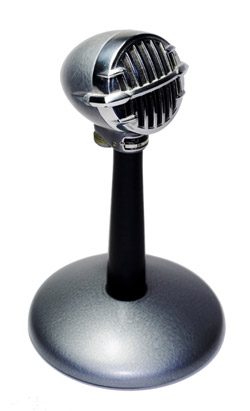MICROPHONES
North Suburban HAMMOND ORGAN Service
Crystal microphones work on the piezoelectric principle. The basic idea is that certain crystals, if subjected to external forces that slightly distort them will produce a voltage related to the amount of force acting upon them.

Figure 3. A typical desk stand crystal microphone.
Crystals of the right type when subjected to forces can generate surprisingly high voltages. If you have ever used certain types of spark lighters where you squeeze a trigger and a blue spark forms at the tip electrodes of the lighter, that voltage is derived from a crystal which gets "snapped" when you pull the trigger of the lighter.
Microphone crystals do not generate high enough voltages to produce visible sparks, but they will, when acted upon by a suitable diaphragm which is vibrated by an impinging soundwave, generate an audio voltage that replicates, reasonably well, the shape of the soundwave hitting the diaphragm. This audio voltage, when sent through a power amplifier can drive a speaker or a recording device.
Crystal microphones offer somewhat better quality reproduction than carbon microphones, and when home or amateur grade reel-to-reel tape recorders first became available for public consumption, you usually would get a crystal microphone included with the recorder.
Crystal microphones can reproduce frequencies a lot greater than carbon mics can handle, but they are also not really capable of high fidelity audio for any serious recording applications. They have the advantage of being simple, fairly cheap and they generate a fairly high voltage (relatively speaking) signal. They are, however, very high impedance devices, and later on we'll touch upon the subject of impedance and its relationship to microphones and audio devices in general.
In a typical crystal mic there is an actual rectangular piece or "slab" of a crystal, and the microphone diaphragm is often arranged to push on the crystal. Wires are attached to the appropriate faces of the crystal and when the crystal deflects even by the minimal amount that the tiny force of the diaphragm can deliver, the crystal generates a corresponding voltage. As the diaphragm vibrates in response to a signal, the crystal voltage follows the vibrations of the diaphragm and we get an AC audio signal. Almost like magic, but it's not magic at all. It's just a physical property of many crystals to produce voltages across opposite faces of the crystal when they are subjected forces that tend to deform them.
Interestingly, the opposite effect is also possible. That is, if a voltage is correctly applied, the crystal will slightly deform, and if this voltage is an audio signal, and the crystal is attached to a suitable diaphragm, the crystal will vibrate the diaphragm enough to produce audible sound. More magic.
Page 3. Previous page | Next page